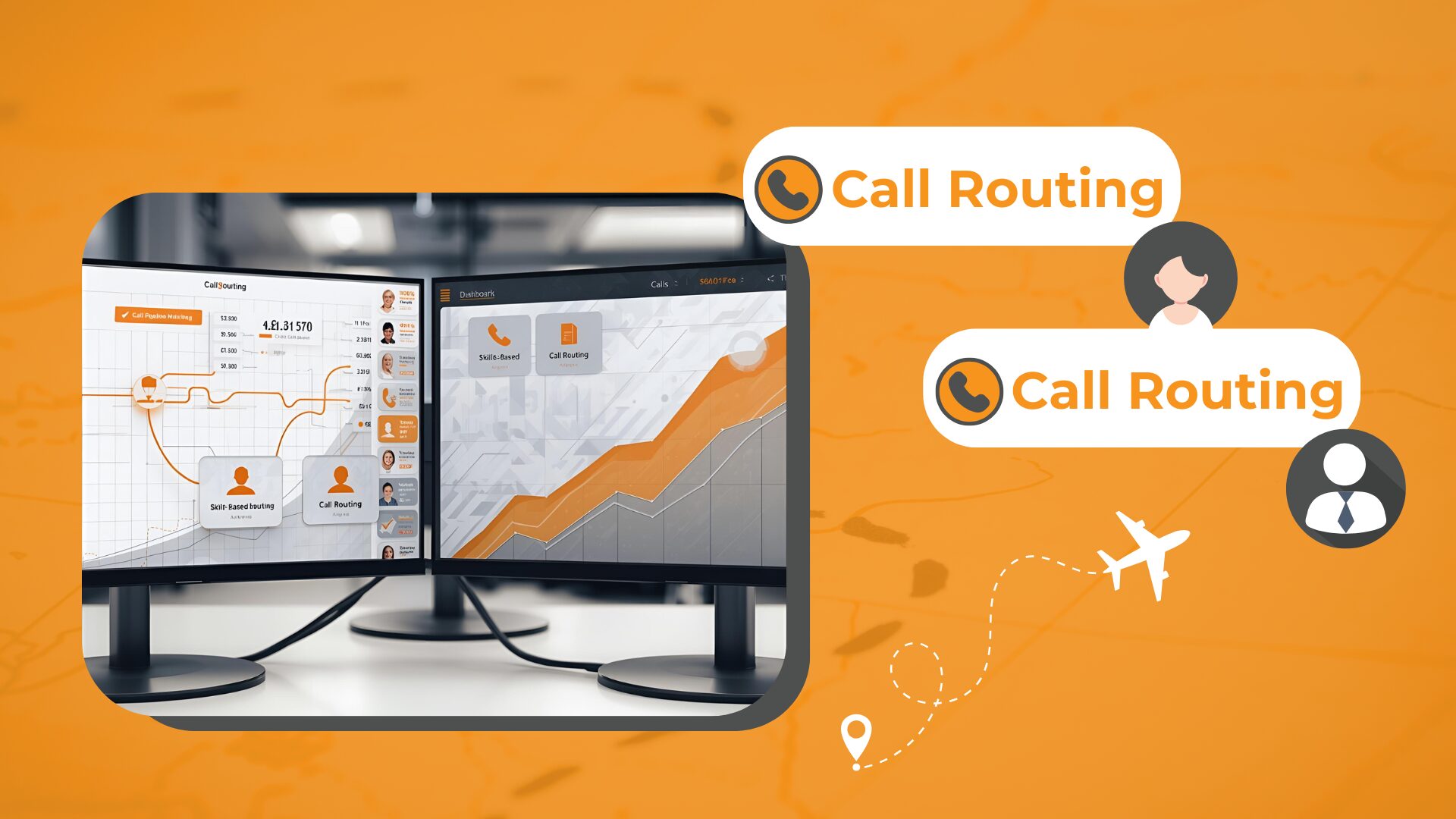Intelligent call routing assigns each caller to the right destination using rules such as IVR options, caller geography, business hours, agent skills, and queue routing. During peak traffic, a structured call flow keeps high-value callers out of voicemail and directs them to trained agents. Businesses that rely on phone calls know that poor call routing strategies lead to longer wait times, abandoned calls, and lower both customer satisfaction and customer service.
AvidTrak combines queue routing, AI-powered conversation outcome extractions and transcription, voicemail callbacks, and scheduled alerts to reduce missed revenue while preserving attribution. These practices allow marketing teams to connect call data from Dynamic Number Insertion to GA4 call conversions and Salesforce call tracking integration.
In this blog, we will discuss the 8 best practices for intelligent call routing in 2025, highlighting how businesses can achieve affordability, dependable product support, and trusted domain expertise through strong solutions such as AvidTrak.
Summary
- Intelligent call routing improves the customer experience by using IVR menus, queue routing, skills-based routing, and geo-routing to reduce abandoned calls and improve first call resolution.
- Clear IVR best practices, including two to four menu options, caller greetings, and call whisper, provide agents with context, reduce caller frustration, and improve customer service outcomes.
- Strong queue routing strategies with ring thresholds, overflow rules, and voicemail callbacks balance responsiveness with service levels while protecting revenue during peak demand.
- Time-based routing, area code routing, and ZIP code routing ensure callers reach the right location, while DNI directs high-value campaigns into priority queues.
- Continuous improvement relies on monitoring, analyzing conversation outcomes, transcription, and reporting, where live monitoring, whisper, and reports provide managers with performance metrics.
- AvidTrak stands out with competitive pricing, excellent customer support, and deep expertise in solving complex routing challenges. AvidTrak integrates advanced features such as multi-level IVR, voicemail callbacks, AI-powered transcription, dynamic number insertion, and CRM connections, giving businesses the confidence to turn every inbound call into a reliable source of growth.
Foundations of Intelligent Routing
The foundation of intelligent call routing relies on key components such as structured IVR menus, business hours, holiday calendars, and skill-based routing. A structured IVR (interactive voice response) menu provides clear options, while business hours and holiday calendars direct calls to live agents or an after-hours routing plan. Queue routing, call transfer rules, and skills-based routing improve first call resolution and customer satisfaction by connecting callers with the right agents.
For multi-location businesses or franchises, area code routing and ZIP code routing connect callers to the nearest branch. These call routing strategies support KPIs such as average speed of answer, abandonment rate, and call-to-lead conversion. AvidTrak strengthens these fundamentals with tools such as AI-powered conversation outcome extraction, transcription, voicemail callbacks, and GA4 call conversions, which turn calls into measurable data that improve the customer experience and support call center operations. With the groundwork established, the next step is to map caller intents and choose the right routing types to keep every interaction efficient.
Map Caller Intents to Destinations
Effective call routing software starts with mapping caller intents into categories such as sales, service, billing, or urgent requests. The principle of “fewest menu choices” keeps IVR menus clear and reduces call abandonment. Routing based on customer profile and call data lowers average handle time and raises the first contact resolution rate. AvidTrak supports this process with AI-powered conversation outcome extraction, transcription, and keyword flags that help identify caller intent beyond menu options.
Choose the Right Routing Types
Different call routing strategies work best for different teams. Choosing the correct method ensures faster response times and better customer experience:
- Sequential routing works well for smaller teams, directing calls one by one.
- Simultaneous routing rings multiple agents at once, reducing caller wait times.
- Skills-based routing matches callers to trained agents, improving customer satisfaction scores and cutting call resolution times.
- Round robin routing distributes calls evenly across agents in sequence, helping balance workloads and maintain consistent service levels.
AvidTrak equips teams to gain access to flexible tools such as call whisper, queue routing, and agent transfers, supporting KPIs including average wait time, occupancy rate, and service level agreements.
8 Best Practices for Smarter Call Routing
Implementing the right call routing strategies is essential for improving customer satisfaction, reducing abandonment rate, and meeting service level agreements. With the fundamentals covered, the following best practices outline how intelligent call routing can turn everyday calls into measurable improvements in service and efficiency.
Best Practice #1: Design IVR for Speed and Clarity
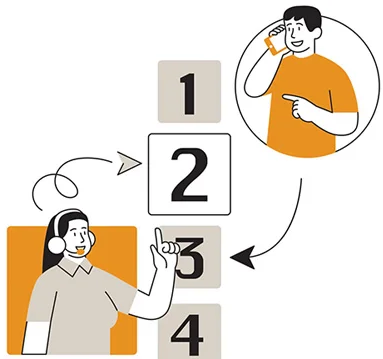
A strong IVR (interactive voice response) menu is the first step in effective intelligent call routing. Callers should never face endless options or confusing paths. Limiting each level to two to four concise choices keeps call flows simple and reduces frustration. Clear wording and consistent numbering across campaigns also improve customer experience and reduce abandoned calls in contact centers.
Multi-level IVR in AvidTrak allows two to four options per level, reducing abandonment and accelerating connections to agents. Short prompts, consistent numbering, and a clear “press 0 to speak to an agent” rule prevent callers from looping. Caller greetings and compliance advisories strengthen trust, while call whisper gives agents valuable context before they connect. These design practices improve first call resolution, protect revenue, and deliver a more consistent customer service experience.
Best Practice #2: Use Queue Logic to Prevent Missed Revenue

Unanswered calls can lead to lost revenue, which is why queue routing is essential. Setting ring durations, max wait times, and fallback transfers prevents abandonment. With AvidTrak’s voicemail callback alerts, businesses can ensure that missed calls are promptly addressed, minimizing lost opportunities.
Effective queue routing strategies balance responsiveness with service levels. Shorter ring cycles keep agents engaged, while queue caps redirect overflow to backup teams. Scheduled alerts by email or SMS notify managers of unanswered calls, allowing for same-day follow-ups. These measures help maintain first call resolution, improve customer satisfaction scores, and protect revenue.
Pro tips for queue logic:
- A five-ring hop for sequential routing keeps agents responsive.
- A two-minute queue cap with overflow to a backup team preserves service levels.
- A voicemail callback workflow with alerts should guarantee same-day follow-up.
AvidTrak’s call routing software provides precise control over queues and transfers with
Best Practice #3: Route by Time, Geography, and Campaign

Strong call routing strategies must account for when and where calls are received. Time-based routing uses business hours and holiday calendars to ensure calls reach available agents. Calls outside these hours should follow clear after-hours routing rules, such as voicemail with a call-back option or redirecting to on-call staff. This approach protects revenue and keeps customer experience consistent.
Location is equally important. Geo-routing connects callers to the right office through area code routing or ZIP code routing
Caller identity can also play a role in routing. With Caller ID routing, AvidTrak lets businesses define rules based on the caller’s number or region, automatically directing those calls to designated teams. Campaign-specific routing further increases precision. Using Dynamic Number Insertion, each campaign or keyword can have its own number, ensuring high-intent callers are directed into priority queues. This setup also supports attribution and reporting, helping marketers identify which ads deliver qualified leads.
Key applications include:
- Time-based routing: Business hours and holidays with after-hours rules.
- Geo-routing: Area code or ZIP code prompts connect to the nearest location.
- Campaign routing: Dynamic Number Insertion assigns unique numbers so high-value calls reach priority queues.
AvidTrak supports time-based, geo-based, and campaign-specific routing with tools such as business-hour calendars, ZIP/area code routing, and Dynamic Number Insertion, making call handling precise and reliable.
Best Practice #4: Match Skills to Call Types
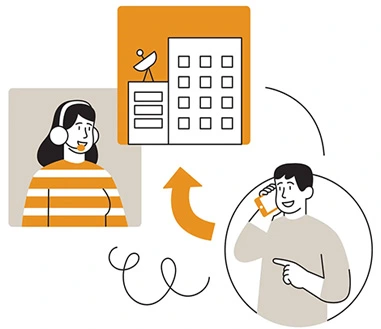
Every call has a different purpose, and routing it to the right agent improves both customer experience and revenue. Skills-based routing assigns calls based on agent expertise, ensuring new prospects reach sales teams, returning customers connect with account managers, and urgent cases go directly to priority agents. This approach improves first call resolution and reduces unnecessary agent transfers.
Tagging agents by skill also strengthens workforce management. Sales representatives focus on direct incoming calls that drive growth, while service specialists handle support or billing requests. This structure increases agent productivity and creates more consistent customer interactions across the contact center.
The choice between simultaneous routing and skills-based routing depends on team needs. Simultaneous ringing is effective for small teams, but it can increase call handle time if agents lack the necessary expertise. Skills-based routing lowers abandonment and directs calls to the most capable agent from the start.
AvidTrak provides flexible skills-based and simultaneous routing options, helping businesses reduce abandonment while improving call resolution and overall customer satisfaction.
Best Practice #5: Protect Caller Trust and Deliverability

Trust is essential in every customer interaction, and call routing works best when both identity and privacy are safeguarded. Outbound calls should be handled through STIR/SHAKEN-verified providers, which help reduce spoofing and increase answer rates. For inbound traffic, businesses need reliable defenses against nuisance calls. AvidTrak’s robocaller blocker filters out automated spam using audio CAPTCHA, protecting agents from wasted time and preserving call queues for genuine prospects.
Privacy protections are equally important in modern contact centers. With password-protected call recordings and automated deletion features, sensitive conversations can be stored securely or removed after set retention periods. These tools help businesses comply with internal data policies while keeping customer service interactions safe.
SMS communication also requires compliance. AvidTrak enables A2P-10DLC registration, allowing companies to register their brand and campaigns with carriers so that text messages are delivered reliably and in line with regulations.
AvidTrak combines identity verification, robocall spam blocking, and data privacy tools to protect caller trust while keeping call routing accurate and compliant.
Best Practice #6: Close the Loop with Attribution and CRM

Effective call routing strategies are not only about directing calls to the right agents but also about connecting those calls back to marketing campaigns. With Dynamic Number Insertion (DNI), each ad, keyword, or landing page can be assigned its own tracking number, showing exactly which tactics generate qualified customer interactions.
In AvidTrak, DNI ties each inbound call to its campaign, ad group, or keyword. GA4 and ad-account posting turn qualified calls into measurable conversions, while CRM posting connects those calls to revenue. This closed loop lets marketers reallocate budgets toward tactics that deliver booked appointments rather than raw volume.
CRM integrations make the process more powerful. Calls can be automatically posted to HubSpot, Zoho, or Salesforce call tracking integration, linking phone leads directly to revenue outcomes. Call outcomes and AI-powered transcription flags provide teams with the insights needed to refine ad copy, audience targeting, and creative decisions. Instead of chasing raw call volume, businesses can prioritize campaigns that consistently convert.
Best Practice #7: Monitor, Coach, and Iterate
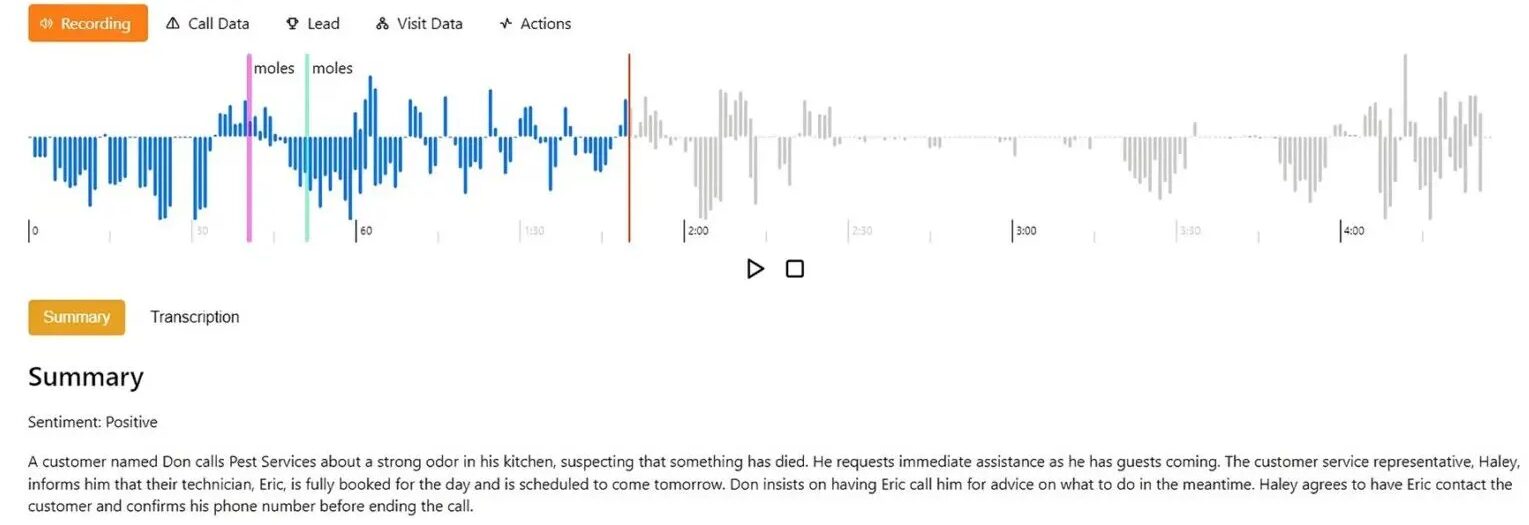
Strong call center analytics rely on continuous monitoring and coaching. Supervisors need visibility into live calls to save opportunities in real time. With AvidTrak, managers can use live monitor, call whisper, and barge to listen in, guide agents privately, or join a conversation when necessary. These tools improve customer interactions during critical moments and help protect revenue.
Beyond real-time coaching, reviews are equally important. AI-powered conversation outcome extraction and transcription with keyword flags allows managers to analyze calls without having to read entire transcripts or replay recordings. By identifying terms related to sales, service, or compliance, businesses can assess quality and adjust training accordingly.
Scheduled reporting ensures that stakeholders stay informed. AvidTrak delivers reports, giving teams access to accurate performance metrics across every route. These reports help managers identify patterns and act quickly.
Weekly KPIs to review include:
- Missed call rate
- Abandonment rate
- Average answer speed
- First-call resolution
- Conversion rates by route
AvidTrak equips businesses with monitoring, conversation outcome analysis, transcription, and reporting features that support continuous coaching and iteration, improving agent productivity and strengthening overall customer experience.
Best Practice #8: Test, Measure, and Roll Out Gradually
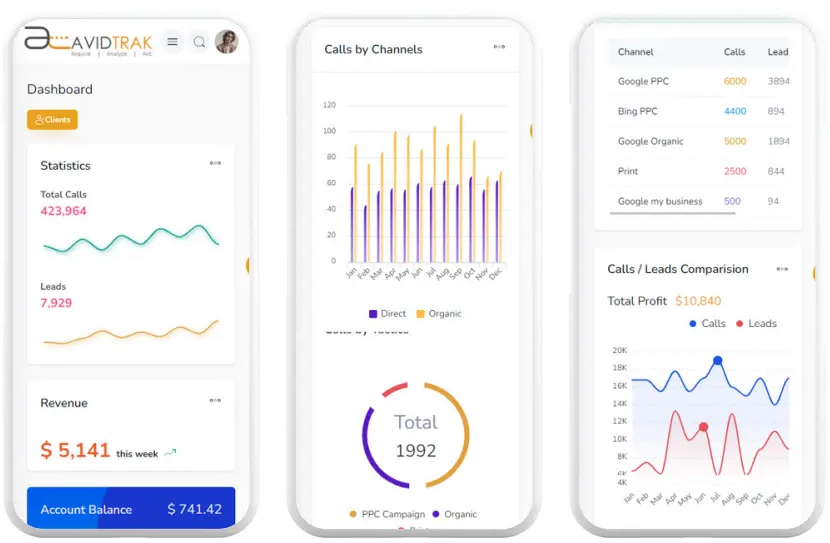
Even the best call routing strategies need testing before being applied across an entire cloud-based contact center. Running controlled A/B tests helps teams evaluate the impact of different routing rules on customer experience and performance metrics.
Rolling out changes in phases reduces risk. Small-scale trials allow businesses to see how adjustments affect customer interactions and agent productivity before expanding them system-wide. With AvidTrak, managers can set alerts, track changes through reporting dashboards, and keep prior routing rules available for quick adjustment if new settings create issues.
This measured approach gives organizations confidence that changes are delivering the desired results. By testing, monitoring, and refining call flows over time, businesses protect revenue, maintain service levels, and create more consistent customer service experiences.
AvidTrak provides alerting, custom dashboards, and flexible routing controls, giving businesses the confidence to test changes without losing track of key performance goals.
Templates and Checklists
Clear frameworks make intelligent call routing easier to design and apply in day-to-day operations. The following tables turn best practices into practical blueprints, showing how to configure routing rules, track KPIs, and maintain compliance.
Each model ties back to AvidTrak’s capabilities, from queue routing and voicemail callbacks to dashboards and compliance controls. These checklists show how routing choices connect to measurable outcomes, giving teams a straightforward way to align daily operations with performance goals.
Table A: Routing Blueprint Template
This routing blueprint can be built in AvidTrak with queue routing, sequential or simultaneous call transfers, after-hours routing, and voicemail callbacks. Each column reflects rules that can be configured within the platform’s dashboard.
| Caller intent | Primary destination | Backup destination | Ring time | Max wait | Overflow rule | After-hours rule | Report recipient |
| Sales | Sales team | Backup sales | 5 rings | 2 min | Overflow to the queue | Voicemail callback | Sales manager |
| Service | Service desk | Account manager | 6 rings | 3 min | Overflow to support | Voicemail callback | Support lead |
| Urgent Calls | Priority agent | Supervisor | 4 rings | 1 min | Barge/transfer | On-call routing | Operations lead |
Table B: SLA and KPI Targets
AvidTrak tracks the average speed of answer, abandonment rate, missed calls, and first-call resolution across every route. These KPIs can be monitored in real time through dashboards. The targets shown here are recommended industry benchmarks that teams can adapt to their own needs.
| KPI | Recommended starting target |
| Average speed of answer | < 20 seconds |
| Abandonment rate | < 5% |
| Missed calls | 0–2 per week |
| First-call resolution | > 80% |
| Sales conversion | > 15% |
| Callback within X hours | Within 24 hours |
Table C: Privacy and Compliance Controls
AvidTrak provides password-protected call recordings, auto-deletion timelines, custom retention windows, STIR/SHAKEN verification, and A2P-10DLC registration. These features align directly with the following compliance controls.
| Control | Notes |
| Password-protected recordings | Protect recordings from unauthorized access |
| Auto-deletion timelines | Set automated deletion rules for data privacy |
| Data retention windows | Configure storage duration based on company policies |
| STIR/SHAKEN posture | Verified caller identity for outbound calls |
| A2P-10DLC registration for SMS | Register brand and campaigns for compliant messaging |
Why Choose AvidTrak for Intelligent Call Routing
The best practices outlined in this guide highlight how intelligent call routing can improve customer experience, protect revenue, and strengthen business operations. Achieving these results requires more than technology alone; it takes affordability, reliable product support, and proven expertise.
AvidTrak delivers on all three. Businesses gain a cost-effective platform that combines 14 years of domain expertise with responsive support to solve both simple and complex call management challenges. From multi-level IVR to AI-powered conversation outcome extraction, transcription, Dynamic Number Insertion, and CRM integration, AvidTrak provides the tools needed to turn calls into measurable growth.
Sign up for a free trial with AvidTrak today and see how intelligent call routing transforms your customer interactions.
FAQs
1. What is intelligent call routing?
Intelligent call routing directs each caller to the best destination using rules such as IVR best practices, business hours, agent skills, and caller geography. With AvidTrak, queue thresholds and voicemail callbacks can be added to prevent missed revenue during peak demand while improving first call resolution.
2. What routing types should teams consider?
A balanced plan often uses sequential or simultaneous ringing for small teams, skills-based routing for larger groups, and overflow transfers during spikes. AvidTrak supports queue routing and transfers, ensuring unanswered calls never stall in one ring group.
3. How should a business handle after-hours calls?
An effective after-hours plan includes a voicemail greeting, transcription with keyword flags, and a callback workflow supported by alerts. AvidTrak provides voicemail callbacks and scheduled alerts so managers can assign follow-ups the next business day and keep service levels consistent.
4. How does geo-routing work for franchises?
Geo-routing connects callers to the right office using the area code or a prompted ZIP code. AvidTrak supports both area-code and ZIP-code routing, allowing national campaigns to send local callers directly to the nearest branch or franchise location without delay.
5. How does call routing connect to marketing ROI?
When routing integrates with Dynamic Number Insertion, GA4, and ad-platform posting, marketers see which ads or keywords drive qualified calls. AvidTrak connects calls to Salesforce, HubSpot, and Zoho, turning them into measurable revenue outcomes and enabling budget shifts toward campaigns that produce booked appointments.
6. Why mention STIR/SHAKEN in routing best practices?
STIR/SHAKEN verifies caller identity, reducing spoofing and improving answer rates. Teams that route callbacks or outbound follow-ups benefit from this verification. AvidTrak uses STIR/SHAKEN-verified carriers, helping businesses protect their reputation and maintain customer trust.
7. What coaching features improve routed calls?
Supervisors can monitor live calls, whisper guidance to agents, or barge into conversations when needed. AvidTrak adds AI-powered conversation outcome extraction, transcription, and keyword flags, letting managers review specific call moments without replaying complete recordings, which supports faster training and higher agent productivity.


